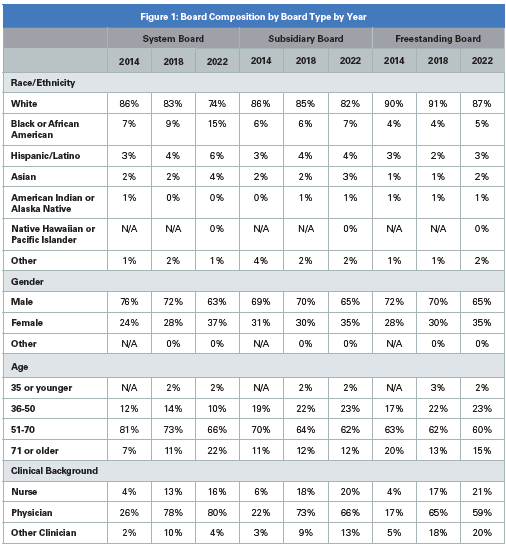Building a Governing Board Strategy on Diversity and Health Equity
Case Studies from the Field

Contents
Boardroom Interview 1
Luis Jose Maseda (UMass Memorial Health)
Boardroom Interview 2
James Liggins (Bronson Healthcare)
Boardroom Interview 3
Jacqueline Ortiz, Bettina Tweardy Riveros, Logan Herring, Sr. (ChristianaCare)
Boardroom Interview 4
Mae Douglas (Cone Health)
Boardroom Interview 5
Tina Freese Decker, Mark Davidoff, Carlos Cubia (Corewell Health)
I’m a Board Director. Where Do I Go Next?
Where Does My Organization Go From Here?
Introduction
Hospital and health system board members can be transformative leaders through a demonstrated commitment to health equity and diversity. As business and civic leaders who represent their communities, board members oversee the strategic direction for their health care organizations. As critical decision-makers, they can develop intentional strategies for improving health equity for their hospitals and health systems. Boards can begin by ensuring they are diverse in composition, thought, and skill set, with a clear duty of loyalty to the communities served. The board should develop a diversity strategy and ensure that health equity is included in their organization’s strategic plan. Diligently executing a long-term strategic plan and monitoring success are equally important to ensure strategies create measurable impact in the communities served.
Prioritizing health equity has been top of mind for many executives and boards across the health care ecosystem, especially because research shows that a diverse and representative health care workforce improves patients’ access to care, their perceptions of the care they receive and, most importantly, health outcomes. In particular, studies have indicated meaningful improvements in health outcomes when patients’ health care teams mirror their personal characteristics.
Boards play a pivotal role in ensuring strategies and budgets result in actions to drive performance, impact, and measurable progress. Leaders from the American Hospital Association (AHA), the Black Directors Health Equity Agenda (BDHEA) and The Health Management Academy (THMA) interviewed nine executives and board members from health systems across the country to better understand how their respective organizations are prioritizing diversity and health equity and inclusion and demonstrating their commitment to health equity with actionable results.
Notable Trends in Board Diversity
From November 2021 through March 2022, the American Hospital Association (AHA) conducted a survey online of hospitals and health systems across the country to examine governance trends and practices. This 2022 Health Care Governance Survey Report (Governance Report) collected data from 933 hospital and health system CEOs. Overall, the respondents were generally representative of hospital bed size and geographic distribution in the United States.1
Consistent with trends in a health care field that continues to undergo a substantial transformation, the AHA’s2022 Governance Report describes evolving board structures, practices and focus areas. Below are a few key graphics from the Report that illustrate the state of board diversity today.
Board Composition by Board Type Across Hospital and Health System Boards: Race, Gender and Age Trends.

Participants reported more racial and ethnic diversity, along with a higher percentage of female members in 2022. Gender diversity on boards has gradually increased over the past 17 years. In 2022, survey respondents reported 36% of their members were female, compared with 30% in 2018, 28% in 2014 and 2011, and 23% in 2005 (Figure 1). While the increase in female representation on boards is positive over the last 17 years, the disparity between females and males still exists.
Various initiatives, mentorship programs and advocacy groups have emerged to address this gender gap, aiming to support and promote women into leadership roles within health care to include board membership.
Representation by Age Across Hospital and Health System Boards
Similar 2022 AHA survey data also indicates that there is a growing percentage of older board members among hospitals and health systems. The percentage of boards with members ages 50 or younger (19%) has continued to decline compared to 2018 (22%), 2014 (21%), 2011 (24%) and 2005 (29%).

In 2022, boards overall had a higher percentage of members age 71 or older (18%) than did boards in 2018 (12%), 2014 (10%), 2011 (9%) and 2005 (9%). In 2022, 12% of freestanding hospital boards reported having a board member age limit, compared with only 2% in 2018 (Figure 3).

While some progress is being made to diversify boards, much more needs to be done. Boards focused on diversity and health equity have different approaches. AHA, BDHEA and THMA collaborated to show examples of how hospitals and health systems are diversifying their boards and executing intentional strategies to advance health equity across the United States.
The following one-on-one interviews cover topics such as leadership, priority setting, measuring progress for diversity and health equity initiatives. The organizations highlighted in this resource stand out for their demonstrated commitments to diversity and health equity, widespread engagement and accountability across their executive leadership teams and boards, and meaningful long-term engagement with the communities they serve.
We hope this information will be useful to assist others in undertaking a comprehensive organizational approach to hardwiring diversity and health equity as a key component of their operations. Thank you to each of the interviewees for their time and for sharing their diversity and health equity journeys.
- Not-for-profit organizations were somewhat overrepresented and investor-owned organizations were underrepresented in the survey results.
